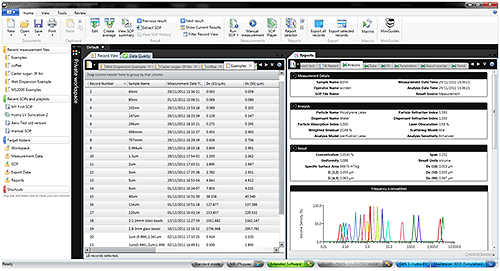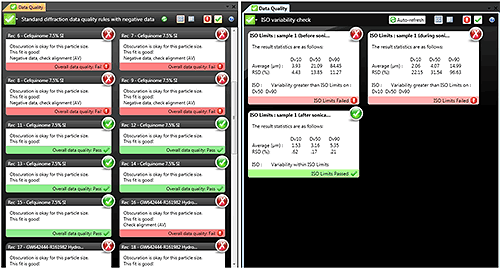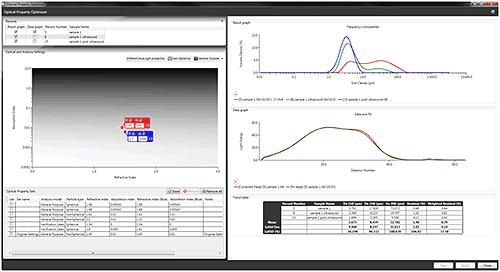Since its launch in 2011, Mastersizer 3000 has rapidly become the particle sizing system of choice for both R&D and QC/QA applications. So, why are customers deciding to migrate to the new system from the Mastersizer 2000?
This white paper outlines the capabilities of the Mastersizer 3000 and highlights the support Malvern provides to help you transfer methods from the Mastersizer 2000 to the new system.
| MS3000 | MS2000 |
|---|---|
| 690mm x 300mm x 450mm (LxWxH) | 1293mm x 255mm x 375mm (LxWxH) |
Laser diffraction is now the world’s most widely applied method for particle size analysis as part of quality control. As the technique has moved into standard laboratories, the pressure on bench space becomes an important consideration. In designing the Mastersizer 3000, Malvern has reduced the system footprint by almost half. The dispersers are also reduced in size and weight. This gives you the flexibility to place your system in the fume hood and frees up space for other vital equipment.

|
| MS3000 | MS2000 |
|---|---|
| 10nm – 3.5mm | 20nm – 2mm |
When you purchase a particle size analyzer, you need one which can keep pace with your own product development requirements. This often means that acquiring an instrument which can operate over a wide particle sizing range can be advantageous to you and your organization.
In order to measure over a wide range, most diffraction systems use multiple wavelengths of light, or multiple light sources. There is also a requirement to measure over as extensive a range of scattering angles as possible. In the Mastersizer 3000, we have engineered our smallest detector yet, enabling us to measure a maximum particle size of 3.5mm, even though the optical bench size is much shorter than the Mastersizer 2000. In addition, we optimized the way measurements are made at different wavelengths. The Mastersizer 3000 introduces the red and blue light sources to the sample on exactly the same path. This, coupled with an increase in the blue light power, provides better sensitivity in the 10nm-1000nm size range.

|
Different applications require different dispersers. We know that some materials are best measured using dry dispersion, using the Aero S or the Scirocco 2000 dispersers, whereas others will need to be measured using liquid dispersion, using our Hydro series of dispersion units.
Now the question is, how much material do you have? For dry dispersion, we can easily measure large samples of up to 10g using the Aero S hopper-based sample feed tray. However, the improvements we’ve made in dispersion efficiency, in combination with the ability of the Mastersizer 3000 to measure at a rapid data acquisition rate of 10,000 measurements a second, mean we can analyze small sample quantities as well. Although the smallest mass we can measure is sample dependent, we have proven that the Aero S can measure as little as 5mg.
For applications requiring liquid or wet sample dispersion, the Hydro LV covers a similar range of applications to the Hydro 2000G, providing a 600ml sample tank which can disperse larger samples of polydisperse materials. For smaller sample quantities, the Hydro MV provides a replacement for the Hydro 2000S, helping you minimize the use of expensive organic dispersants and samples. All of the Mastersizer 3000 liquid sample handling units are chemically compatible, ensuring a wide range of dispersants can be used. Direct software control of variable power in-line sonication, sample pumping/stirring, system cleaning and dispersant filling are provided.
If your samples do not require internal sonication then the Hydro SV small volume liquid sample dispersion unit can be used. This has a total dispersant volume of only 6-7ml, enabling wet measurements to be quickly and easily carried out for milligram sample quantities.
The Mastersizer 2000 has always been praised for its software flexibility and ease of use. In developing the Mastersizer 3000, we wanted to build on this capability and bring it up to date using the latest software tools.
When you look at the Mastersizer 3000 software, all the elements you’d recognize from the Mastersizer 2000 are there including the records view, report views, SOPs and data export capabilities. However, we’ve now made everything easier to access and configure. For example, reports can now be designed in-place. Filtering and sorting of measurement records has been significantly improved, allowing you to more easily find data relating to different product types. We’ve also made it possible to compare measurements between different measurement files without needed to make multiple copies of records. Finally, a new SOP comparison tool makes it easy to compare the methods applied in creating results, making it easier to detect any method differences and therefore troubleshoot any issues with measurement reproducibility.

|
The Mastersizer 3000 measurement interface is designed to provide you with instant feedback on the measurement process, allowing you to easily follow the process of method development. The new measurement manager guides users through each stage of the measurement process. During method development, it also gives direct access to all of the dispersion unit controls, allowing you to explore how changes in the dispersion conditions affect your measurements. The biggest improvement we’ve made over the Mastersizer 2000, however, is the inclusion of a live result trend view. This shows the current result and light scattering data along with a trend plot showing how the sample particle size has changed during the measurement sequence. This immediately allows you to assess the stability of your measurements. Automatic statistics calculations (mean, max, min, standard deviation)are also provided, allowing you to check if the measurement repeatability is within acceptable limits.

|
At Malvern, we always try to provide good training and support, in order to enable you to get the most out of your investment in a Mastersizer particle size analyzer. However, wouldn’t it be great to have a Malvern expert with you in the lab, to advise you on the quality of the measurements you make? The Mastersizer 3000 Data Quality tool offers this capability, helping you to understand how your measurements can be optimized. Once this is done, we can also check the variability of your data, confirming whether your results meet the reproducibility requirements outlined in norms such as ISO13320:2009 and USP<429>. In addition to this, you can build your own custom calculations for applying your own quality parameters if required.

|
One of the core capabilities of the Mastersizer 2000 was its ability to apply the Mie scattering model in order to calculate the particle size distributions of samples containing very fine particles. This enabled the reporting of accurate results across the measurement range of the system. However, the use of Mie Theory requires you to specify the refractive index and absorption (imaginary refractive index) of any samples being tested. This is often a challenging requirement, especially when measuring new materials.
The Mastersizer 3000 applies the same rigorous analysis approach as used in the Mastersizer 2000, ensuring you can make the most of its measurement capabilities. The requirement to provide optical properties therefore remains. However, a unique Optical Property Optimizer tool is now available, enabling you to rapidly understand how changes to the selected refractive index and absorption values affect the reported particle size distribution. This is a significant aid to producing robust measurement methods.

|
With laser diffraction being used within many quality control applications, the data generated using the technique has become increasingly business critical. This places requirements on the quality of the results generated by the system. However, it also requires that the system be easy to maintain between routine measurements.
The requirement for easy maintenance has led to the design of a new cell for the Mastersizer 3000 system. The need for special tools and manual tightening of the measurement cell windows, such as is required with the Mastersizer 2000, has been removed. With Mastersizer 3000 a simple flip of a lever splits the measurement cell, making for faster and simpler access to the inner surfaces of the cell windows for cleaning. This makes it easier to keep the system working optimally.

|
Malvern also understands that it can be difficult to remember to carry out routine maintenance tasks. To address this, we’ve introduced a maintenance scheduling tool in the Mastersizer 3000 system, which enables you to set up reminders for users to carry out simple preventative maintenance tasks. This can also be used to schedule yearly verification checks or routine service visits. In addition, a new system health check tool is available to ensure you system is connected correctly and responding to software commands as designed.

|
From the outset, the Mastersizer 3000 has been developed with all the features required to ease method transfer from the Mastersizer 2000. Mastersizer 2000 record files can be opened within the Mastersizer 2000 software. What’s more, if the data is saved in a Mastersizer 3000 format measurement file you can then reanalyze your results in the Mastersizer 3000 software using all of the standard analysis options from the Mastersizer 2000 software. The Mastersizer 3000 software therefore provides a long-term solution to accessing your archive of sample results.

|
In general, we have found that the Mastersizer 3000 generates results which are very close to the Mastersizer 2000. For this reason, many Mastersizer 2000 users have already transferred across to the new system. Malvern is also happy to analyze your samples to show the agreement between the two systems, to help you make your decision.

|
For course, there may be situations where differences in analysis performance may be observed. In particular, the measurement range of the Mastersizer 3000 system is wider than the Mastersizer 2000, which may cause particles to be measured which could not be observed using the Mastersizer 2000. In addition, we improved the measurement resolution below 1 µm for both wet and dry measurements. In order to cover these situations, Malvern has developed a Mastersizer 2000 analysis mode within the Mastersizer 3000 software. When this is used, the capabilities of the new system are switched to be similar to the Mastersizer 2000, making specification transfer much easier.

|
Every product has an end of life. Malvern makes provisions and planning for hardware, software and applications support for up to seven years beyond the end of a product’s production cycle. We then try our best to provide support beyond this if we can. As a result, there will be a significant period of time when both the Mastersizer 2000 and Mastersizer 3000 systems will be supported together. Clearly, however, the expected lifetime of the Mastersizer 3000 extends further into the future compared to the Mastersizer 2000. This is why Malvern have worked hard to enable transfer to the new system to be achieved as easily as possible. We also offer full planning and assistance to our customers when change occurs.